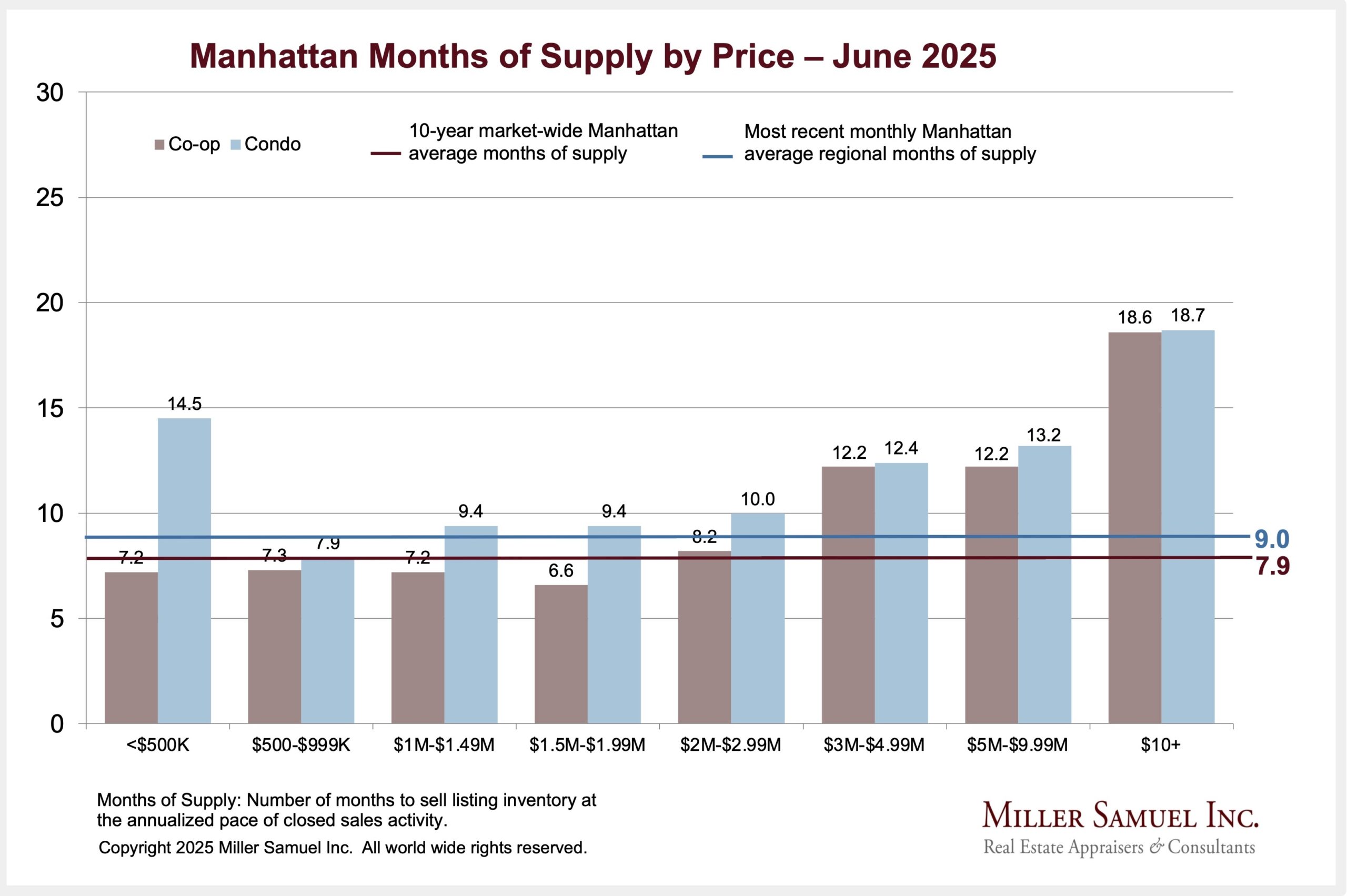The drummer from my favorite band, the Pixies, has a magic trick. Wait for it…
But I digress…
Manhattan Sales Have Clawed Back From The Housing Abyss
I’ve been the author of the expanding Elliman Market Report Series since 1994 and it has been a journey that never fails to disappoint. Douglas Elliman is only interested in conveying what market conditions are, rather than what some want them to be in order to help consumers navigate changing conditions with a neutral benchmark. Our first and most followed market report covers the Manhattan sales market and it was released today.
After many wrote off the future of cities as doomed, leaving markets like Manhattan with only a handful of residents, consumers opted to return in short order, with the first step measured in sales exceeding year-ago levels for the first time in four quarters. Sales were up year over year as consumers were pulled in by lower prices and lower mortgage rates in addition to growing evidence of a safer city as the implementation of COVID-19 vaccinations has accelerated faster than expected. It is more accurate to describe the market as “recovering” rather than “recovered” and 2021 is expected to illustrate this continuing improvement in housing conditions.
Even with the markets closed today, news of a recovering Manhattan housing market was the fourth most read story of the day by the ±350K Bloomberg Terminal subscribers
The Bloomberg piece has a cool chart using our bidding war data which shows the market is not as frenzied as being depicted by many but the overall optics are conveying improvement.
The New York Times presented my favorite, best nuanced, title for what our market report conveyed: Manhattan Sales Market Is Poised for a Revival, Just a Year After It Collapsed.
The Wall Street Journal and Mansion Global provided clear takes on the results as did Fox Business. My conversation with Brick Underground prompted the M5 post below. I know there is a more coverage coming as real estate reignites to dominate residents’ backyard (or illegally on the balcony) BBQ conversations.
Elliman Report: Manhattan Sales Q1-2021
Elliman Report: Northern Manhattan Sales Q1-2021
______________________________________________________
MANHATTAN SALES MARKET HIGHLIGHTS
Co-ops & Condos
Manhattan sales exceed year-ago levels for the first time in four quarters.
– The number of sales exceeded the year-ago total for the first time in four quarters
– The market share of bidding wars fell to its second lowest level in nearly thirteen years of tracking
– Listing inventory continued to see annual increases skewed towards smaller apartments
– Median sales price for co-ops and condos individually declined year over year
– Co-op sales more than doubled since the end of the spring lockdown
– Highest market share of financed condo sales in seven years of tracking
– All luxury price trend indicators fell short of year-ago levels, seeing larger declines than non-luxury
– Luxury listing inventory expanded year over year for the first time in five quarters
– New development sales below the $3 million threshold surged year over year
______________________________________________________
NORTHERN MANHATTAN SALES MARKET HIGHLIGHTS
Apartment listing inventory has trended lower since the lockdown ended as townhouse sales pressed higher.
Co-ops & Condos
Listing inventory has trended lower quarter over quarter for the second straight quarter but remains well above year-ago levels. All price trend indicators fell short of year levels but rose from the prior quarter.
Townhouses
Price trend indicators showed mixed year over year results while sales expanded. Listing inventory jumped as marketing time expanded from the prior-year quarter.
[M5] Miller Median Market Makeover Mandate or “How Median Subsets Don’t Bracket The Total”
In today’s Elliman Report: Q1-2021 Manhattan Sales release, the YOY change in median sales price for the overall apartment market (co-op+condo) was +1.4%…
…yet the sum of the parts didn’t seem to correlate since co-op median sales price declined 3.8%…
…and condo median sales price declined 4.7%.
Over the past decade this has happened about a half dozen times including resales versus new development. I would get questions from reporters and real estate agents about it so I ended up writing a blog post in 2017 called: Explainer: Overall Median Sales Price Submarket Changes May Not Fall In Range.
The bottom line here is that unlike using “average” is that median is the “middle” number of the data being analyzed while “average” is proportional and most people correlate numbers in a proportional way.
So in this week’s market report, it was important to convey that both co-op and condo markets declined 4-5% year over year. This is a flaw in median sales price but it is still the preferred metric to analyze the real estate market because it removes the outliers.
If you’re still with me, here’s a color-coded chart I whipped for that 2017 blog post to try to explain all this (click on the chart to expand):
The Spread Between Manhattan and Brooklyn Rents Is Shrinking
In my more or less monthly data contribution to the New York Times Calculator Column, in each Sunday’s real estate section, we explored the narrowing gap between Manhattan and Brooklyn rents. Ironically, the pandemic brought Manhattan and Brooklyn rents closer together.
New Signed Contract Volume Remains Hot And Heavy
Across the four regions we produce new signed contract reports for Douglas Elliman, activity levels remain quite high although I suspect we will see some of the edge come off the results next month as mortgage rates continue to rise a bit.
Elliman Report: March 2021 New York New Signed Contracts
Elliman Report: March 2021 Florida New Signed Contracts
Elliman Report: March 2021 Colorado New Signed Contracts
Elliman Report: March 2021 California New Signed Contracts
More Bubble Talk-Downs: Monthly Payment Is Way More Important Than Housing Price
Barry Ritholtz presents a clear discussion why we are not in a bubble in Not a Housing Bubble, also adding some of his colleague Ben Carlson’s analytic handiwork.
Please read the post: Not a Housing Bubble.
My favorite part of this post:
Ben adds “the wave of millennials buying means demographics is going to be a huge force in driving the next 5-7 years at least.” In other words, future housing demand is structural, not this speculative.
Getting Graphic
Our favorite charts of the week of our own making
Appraiserville
(For earlier appraisal industry commentary, visit my old clunky REIC site.)
Appraisal Institute Education Continues To Lose Its Relevance As Nepotism Impeded Future Planning
If you are like me and many other appraisers, I take a lot of my courses online through McKissock. Throughout most of my career until the past decade, taking classes through the Appraisal Institute was the gold standard and it was an important revenue stream for the trade group. Early on in my career an AI instructor joked that “MAI” stood for “More Annual Income” but in my residential litigation work, a number of lawyers told me residential appraisals done by an “MAI” stood for “Made As Instructed.” For commercial work, I hold most “MAIs” I know in very high regard.
Over the past decade, as technology for remote learning ramped up, and AI cronyism evolved nee´ 2007 which has been well-chronicled here, the Appraisal Institute dropped the ball on their education initiative and has been crushed by McKissock which continues, like AMCs to drive prices lower. The pandemic lockdown has been an exclamation point on the future dominance of remote CE credits. We can argue that once the pandemic ends or becomes more manageable, on-site CE classes will be back. However I would posit that they will not return anywhere near the levels achieved pre-COVID and were already declining.
How did this happen?
Through financial gerrymandering, the FOJ crowd essentially owned the ability to teach the lucrative AI courses in person and it was nearly impossible for new talented instructors to become part of the approved teaching corp. FOJs were “milking the cash cow” so there was no awareness or input entertained about the future of the sector. This is the same phenomenon that impacted the BoD and executives over this period.
Like the way FOJs looked down on the residential members, aspiring to go full-on commercial, they also shunned online education, instead electing to view education as a way to go “premium” and abandon the bulk of the CE appraisal market. How can they be seen as a valuable investment by new entrants into the profession when they are being ignored?
AI should be dominating CE education instead of raising membership fees to keep the shrinking ship from sinking. The lack of vision caused by the echo chamber of current leadership will be the organizations eventual downfall at memberhip’s expense unless there is dramatic change.
This is a reminder that the time for complacency of membership is over and change is needed immediately. That old saying “grow or die” seems appropriate for this moment in time.
OFT (One Final Thought)
We lost John Prine in 2020 to COVID-19 but we’ll always have his songs.
Brilliant Idea #1
If you need something rock solid in your life (particularly on Friday afternoons) and someone forwarded this to you, or you think you already subscribed, sign up here for these weekly Housing Notes. And be sure to share with a friend or colleague if you enjoy them because:
– They’ll be more pixie dust;
– You’ll be more magical;
– And I’ll chart it.
Brilliant Idea #2
You’re obviously full of insights and ideas as a reader of Housing Notes. I appreciate every email I receive and it helps me craft the next week’s Housing Note.
See you next week.
Jonathan J. Miller, CRP, CRE, Member of RAC
President/CEO
Miller Samuel Inc.
Real Estate Appraisers & Consultants
Matrix Blog
@jonathanmiller
Reads, Listens and Visuals I Enjoyed
- Not a Housing Bubble [The Big Picture]
- Compass IPO: Brokerage Begins Trading on NYSE [The Real Deal]
- Tenants and Landlords’ Future Hang in Balance Over State Budget. Here’s What That Means [The City]
- How Did Frasier Afford His Apartment? [GQ]
- The Mortgage Market Is Roaring, But Lots of People Can’t Get a Loan [Wall Street Journal]
- The Problem With Timing The Housing Market [A Wealth of Common Sense]
- This Silver Spring House Got a Whopping 88 Offers [Washingtonian (DC)]
- Why there are so few real estate agents of color [HousingWire]
- Bethesda's Kenwood Neighborhood Will Restrict Access to Its Famed Cherry Blossoms [Washingtonian (DC)]
- As the Housing Supply Hits a Record Low, Is There Anything Left to Buy? [Architectural Digest]
- Mortgage Firms Warned to Prepare for a ‘Tidal Wave’ of Distress [Bloomberg]
- $145M Hamptons Estate is Under Contract, May Break Record [The Real Deal]
- 111 West 57th Street's Exterior Hoist Disassembled in Midtown, Manhattan [New York YIMBY]
- Buying a Home Through an LLC Is Not as Anonymous as It Used to Be [Wall Street Journal]
- NYC Exodus May End in April 2021: Nancy Packes Report [The Real Deal]
- Co-op boards may have to explain why they rejected a buyer [Brick Underground]
- How California Set Off a Backyard Apartment Boom [Bloomberg]
- JPMorgan, Salesforce Join Growing List of Firms Dumping Office Space [Wall Street Journal]
- Covid-19 Clobbered Manhattan. Lower Rents Could Seed Recovery. [Wall Street Journal]
- Can Co-ops and Condos Limit Gym Use to the Vaccinated? [Habitat Magazine]
- Remote Work Is Here to Stay. Manhattan May Never Be the Same. [NY Times]
- Meet the Teen Who Hates 432 Park More Than Anyone [Curbed]
- Heard of We Buy Ugly Houses? Here’s how it works — and why it’s so popular [Miami Herald
- How Much Can New York Squeeze Out of Someone? [Commercial Observer]
- A $400,000 house got 122 offers in 2 days, highlighting the desperate frenzy buyers are facing amid skyrocketing real-estate prices and a dearth of homes for sale [Business Insider]
- The Tower Replacing the Grand Hyatt Is an Absolute Behemoth [Curbed]
- Modest Rise In Mortgage Rates Unlikely To Slow Housing Boom [Bankrate]
- House Prices Are Inflating Around the World [Wall Street Journal]
- HFZ Foreclosure Snags Marble Collegiate Church [The Real Deal]
- Mayor Ends Remote Work for 80,000 in Signal to Rest of New York City [NY Times]
- Is it a Bubble? GS Edition [The Big Picture-Ritholtz]
My New Content, Research and Mentions
- Manhattan sales show an increase for the first time in four quarters [Brick Underground]
- Manhattan Residential Sales in March Soared to Highest Level in 14 Years [Wall Street Journal]
- Manhattan’s Sales Market Continues to Recover, But Luxury Closings Lag [Mansion Global]
- First-time buyers fuel Manhattan housing market revival [Fox Business]
- Manhattan Homebuyers Are Back, But They’re Here for the Deals [Bloomberg]
- Manhattan Sales Market Is Poised for a Revival, Just a Year After It Collapsed [NY Times]
- Explainer: Overall Median Sales Price Submarket Changes May Not Fall In Range [Miller Samuel]
- The Brooklyn-Manhattan Rent Gap Is Shrinking Fast [NY Times]
- Raising the Roof: Here Are the 10 Cities Building the Most Homes for Buyers [Realtor]
- Learn to invest in real estate with this $30 course bundle [Newsday]
- De Blasio Admin Brings NYC Workers Back to Offices [The Real Deal]
- 10 Ways the Kitchen is Evolving for Greater Efficiency, Health [Realtor Magazine]
Recently Published Elliman Market Reports
- Elliman Report: Northern Manhattan Sales 1Q 2021 [Miller Samuel]
- Elliman Report: Manhattan Sales 1Q 2021 [Miller Samuel]
- Elliman Report: Colorado New Signed Contracts 3-2021 [Miller Samuel]
- Elliman Report: California New Signed Contracts 3-2021 [Miller Samuel]
- Elliman Report: Florida New Signed Contracts 3-2021 [Miller Samuel]
- Elliman Report: New York New Signed Contracts 3-2021 [Miller Samuel]
- Elliman Report: Manhattan, Brooklyn & Queens Rentals 2-2021 [Miller Samuel]
Appraisal Related Reads
- What is a Pass-through Bedroom? [Tom Horn/Birmingham Appraisal Blog]
- Unlawful Restrictive Covenants – What Are Racially Restrictive Covenants? [Appraisers Blogs]
- Forms Redesign Extended Into 2023-24 [Appraisers Blogs]
- Appraisers Are Sitting Ducks to Random Legislation [Appraisers Blogs]
- Special briefing on the impact of race and socio-economic status on the valuation of homes by neighborhood [American Enterprise Institute – AEI]
- Is This Discrimination? [Cleveland Appraisal Blog]




















![[Podcast] Episode 4: What It Means With Jonathan Miller](https://millersamuel.com/files/2025/04/WhatItMeans.jpeg)